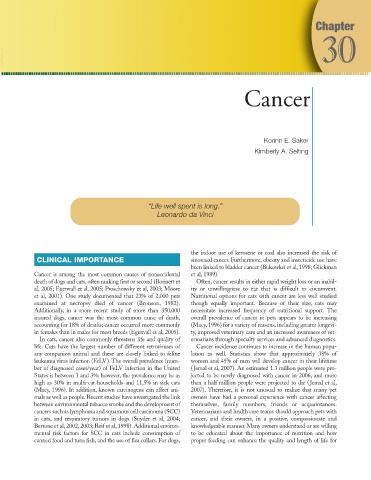Page 566 - Small Animal Clinical Nutrition 5th Edition
P. 566
Chapter
30
VetBooks.ir
Cancer
Korinn E. Saker
Kimberly A. Selting
“Life well spent is long.”
Leonardo da Vinci
the indoor use of kerosene or coal also increased the risk of
CLINICAL IMPORTANCE sinonasal cancer. Furthermore, obesity and insecticide use have
been linked to bladder cancer (Bukowksi et al, 1998; Glickman
Cancer is among the most common causes of nonaccidental et al, 1989).
death of dogs and cats, often ranking first or second (Bonnett et Often, cancer results in either rapid weight loss or an inabil-
al, 2005; Egenvall et al, 2005; Proschowsky et al, 2003; Moore ity or unwillingness to eat that is difficult to circumvent.
et al, 2001). One study documented that 23% of 2,000 pets Nutritional options for cats with cancer are less well studied
examined at necropsy died of cancer (Bronson, 1982). though equally important. Because of their size, cats may
Additionally, in a more recent study of more than 350,000 necessitate increased frequency of nutritional support. The
insured dogs, cancer was the most common cause of death, overall prevalence of cancer in pets appears to be increasing
accounting for 18% of deaths; cancer occurred more commonly (Macy, 1996) for a variety of reasons, including greater longevi-
in females than in males for most breeds (Egenvall et al, 2005). ty, improved veterinary care and an increased awareness of vet-
In cats, cancer also commonly threatens life and quality of erinarians through specialty services and advanced diagnostics.
life. Cats have the largest number of different retroviruses of Cancer incidence continues to increase in the human popu-
any companion animal and these are closely linked to feline lation as well. Statistics show that approximately 38% of
leukemia virus infection (FeLV). The overall prevalence (num- women and 45% of men will develop cancer in their lifetime
ber of diagnosed cases/year) of FeLV infection in the United (Jemal et al, 2007). An estimated 1.3 million people were pro-
States is between 1 and 3%; however, the prevalence may be as jected to be newly diagnosed with cancer in 2006, and more
high as 30% in multi-cat households and 11.5% in sick cats than a half million people were projected to die (Jemal et al,
(Macy, 1996). In addition, known carcinogens can affect ani- 2007). Therefore, it is not unusual to realize that many pet
mals as well as people. Recent studies have investigated the link owners have had a personal experience with cancer affecting
between environmental tobacco smoke and the development of themselves, family members, friends or acquaintances.
cancers such as lymphoma and squamous cell carcinoma (SCC) Veterinarians and health care teams should approach pets with
in cats, and respiratory tumors in dogs (Snyder et al, 2004; cancer, and their owners, in a positive, compassionate and
Bertone et al, 2002, 2003; Reif et al, 1998). Additional environ- knowledgeable manner. Many owners understand or are willing
mental risk factors for SCC in cats include consumption of to be educated about the importance of nutrition and how
canned food and tuna fish, and the use of flea collars. For dogs, proper feeding can enhance the quality and length of life for

